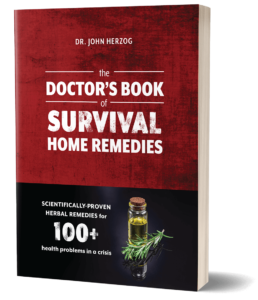Yarrow, scientifically known as Achillea millefolium, is a perennial herb with a rich history of use in traditional medicine. Its name is derived from the Greek mythological figure Achilles, who supposedly used it to treat his soldiers’ wounds on the battlefield. The medicinal properties of yarrow have been the source of several modern studies that seem to support at least some of the traditional uses of it.
Identifying Yarrow
Yarrow can be identified by its feathery, fern-like leaves and clusters of small white or pale pink flowers. The plant tends to grow upright in a cluster, reaching heights of up to 3 feet.

Geographic Distribution
Yarrow is a hardy plant that thrives in a wide range of habitats. It is native to the temperate regions of the Northern Hemisphere, including North America, Europe, and Asia.
Medical Qualities
Yarrow is renowned for its potent medicinal properties. It is considered to have anti-inflammatory, antiseptic, and astringent qualities.
Active Compounds in Yarrow
The therapeutic benefits of yarrow can be attributed to its wealth of active compounds. One of the key components is Achilleine, named after Achilles, which is believed to facilitate blood clotting and support wound healing. Another noteworthy compound is azulene, known for its impressive anti-inflammatory and antiseptic properties. Moreover, yarrow contains flavonoids and terpenes, including camphor and cineole, which are considered to have astringent qualities. These compounds work synergistically to give yarrow its renowned medicinal attributes.
Traditional and Modern Uses of Yarrow
Throughout history, yarrow has been used in a variety of ways. In traditional medicine, it is primarily used to treat wounds and bleeding (both internal and external). It can also be taken orally as a tea or tincture to support the digestive system, reduce fever, and relieve pain from menstrual cramps. The plant is also used in cosmetics and skin care products due to its anti-inflammatory and antioxidant properties. In modern times, yarrow has become renowned for its medicinal properties, with many herbalists recommending it as an alternative natural remedy.

Specific Uses
Yarrow in Wound Healing
Yarrow’s anti-inflammatory and antiseptic properties make it beneficial in wound healing. It helps to reduce inflammation and prevent infection, promoting faster wound healing.
Yarrow in Historical and Modern Wound Care
Historically, yarrow was a staple in many ancient medical practices, credited for its ability to staunch bleeding and disinfect wounds. Its use dates back to the time of Achilles in the Trojan war, where it was used to treat soldiers’ injuries on the battlefield. Its botanical name, Achillea Millefolium, even pays homage to this mythological connection.
In modern times, yarrow continues to be valued for its wound healing properties. Herbalists often recommend using fresh or dried yarrow in a poultice applied directly to wounds, helping to stimulate blood clotting and facilitating tissue repair. Furthermore, the antiseptic properties of yarrow help to prevent secondary wound infections. Research today is delving deeper into the potent compounds in yarrow, corroborating its historical medicinal use and exploring additional potential applications in wound care.
Yarrow leaves possess natural antiseptic, styptic, and antimicrobial properties, making them a popular choice for mitigating bleeding in minor cuts and scrapes. Their ability to slow down blood flow is well-known and widely utilized.
Yarrow also has astringent properties, meaning it can help to constrict pores and expel excess moisture from the skin. This makes it effective in treating rashes, acne, and other inflammatory skin conditions. In particular, yarrow can be used to treat eczema and psoriasis due to its anti-inflammatory effects. It can reduce redness and swelling, as well as soothe itching and irritation.
Yarrow is also known for its antiseptic properties, making it an effective natural remedy for treating cuts, scrapes, burns, or any other type of skin injury. It can help to cleanse the wound while preventing infection from developing. Additionally, yarrow is a gentle yet effective way to soothe rashes, acne, and other skin issues.
https://pubmed.ncbi.nlm.nih.gov/37405118/
Specific Usage of Yarrow in Wound Care
To employ yarrow’s healing properties, the plant, both fresh and dried, was often made into a poultice. This involved grinding or mashing the yarrow into a paste, sometimes mixed with other medicinal herbs. The resultant poultice was then applied directly to the wound. This external application allowed the potent compounds in yarrow to act directly on the site of injury, aiding in clotting, reducing inflammation, and preventing infection. In addition to its use in poultices, yarrow was also brewed into a tea and used as a wash for wounds, providing a less concentrated but still effective method for harnessing its healing capabilities. Today, yarrow continues to be used in similar ways, with many preferring its natural healing properties over synthetic alternatives.
https://pubmed.ncbi.nlm.nih.gov/36836674/
Yarrow for Digestive Health
Traditionally, yarrow has been used to improve digestion and soothe gastrointestinal ailments. It can help to reduce bloating, relieve cramping, and improve overall digestive health.
Historical and Modern Uses of Yarrow in Digestive Health
Historically, yarrow was a go-to remedy for various digestive issues. It was brewed into a tea that was sipped to relieve ailments such as indigestion, bloating, and cramping. The plant’s bitter compounds were believed to stimulate the secretion of digestive juices, thereby aiding in the breakdown of food and absorption of nutrients. The anti-inflammatory properties of yarrow were also utilized to soothe the gut and relieve discomfort associated with gastrointestinal issues.
One of the key compounds found in yarrow that is particularly beneficial for digestive health is called achilleine. Named after the legendary Greek hero Achilles, achilleine has strong anti-inflammatory properties which can help soothe the digestive tract and reduce inflammation. Furthermore, the presence of flavonoids and sesquiterpene lactones in yarrow stimulate the production of bile, a crucial component in the digestion and absorption of fats. This range of compounds working in synergy makes yarrow a potent natural remedy for a variety of digestive disorders.
In modern times, yarrow has maintained its stature as a beneficial plant for digestive health, thanks to numerous scientific studies validating its traditional usage. It’s still commonly used in tea form, either on its own or as part of a digestive health blend. Today, yarrow is also available in capsule or tincture form, providing a more convenient option for those seeking to harness its digestive benefits. Research is ongoing to fully understand the extent of yarrow’s benefits to digestive health, and its potential applications in the treatment of more severe gastrointestinal conditions.
Yarrow for Cardiovascular Health
Research suggests that yarrow may help with blood pressure regulation and overall heart health. While more research is needed to confirm these effects, preliminary studies show promise.
Historical and Modern Uses of Yarrow for Cardiovascular Health
Historically, yarrow has been used for cardiovascular health in many traditional medicines. The plant’s name, Achillea millefolium, refers to the ancient Greek hero Achilles, who is said to have used yarrow to treat his soldiers’ wounds on the battlefield, demonstrating the plant’s association with the circulatory system.
The beneficial effects of yarrow on cardiovascular health are thought to be largely due to certain chemical components found in the plant. These include flavonoids and essential oils. Flavonoids in yarrow are believed to strengthen capillaries and increase their elasticity, thereby preventing blood clot formation. The plant’s essential oils, on the other hand, are thought to exhibit vasodilatory and antispasmodic effects, helping to relax blood vessels and promote healthier blood flow. Additionally, yarrow’s anti-inflammatory and antioxidant properties, likely contributed to by various other phytochemicals in the plant, may also play a role in its heart-protective effects.
Yarrow’s potential benefits to cardiovascular health are now recognized in multiple forms, including teas, tinctures, and capsules, making it a more accessible option for a wider audience. However, as research into yarrow’s cardiovascular benefits continues, it’s important to consult with a healthcare provider before starting any new herbal therapies.
https://pubmed.ncbi.nlm.nih.gov/21684130/
https://pubmed.ncbi.nlm.nih.gov/33610712/
Preparation
Preparation of Yarrow Tincture and Drying
To prepare a yarrow tincture, you’ll need to start with fresh yarrow. The aerial parts of the plant (leaves and flowers) are often used due to their high concentration of beneficial compounds. Harvest the yarrow, then finely chop the plant material to increase the surface area for extraction.
Place the chopped yarrow in a jar and cover it with a high-proof alcohol, such as vodka, covering the plant material by about an inch. Seal the jar and let it sit in a cool, dark place for about four to six weeks, shaking the jar every few days. After this period, strain the mixture, preserving the liquid. The liquid, now your yarrow tincture, can be stored in a dark glass bottle and used as directed by a healthcare provider.
When it comes to drying yarrow, it’s best to harvest the plant on a dry, sunny day after the morning dew has evaporated. Tie the stems together in small bundles and hang them upside down in a dark, well-ventilated area. This helps preserve the plant’s beneficial compounds and prevents mold growth. Once completely dry, store the dried yarrow in an airtight container away from light and heat.
While the aerial parts of the plant are most commonly used in herbal preparations, different parts of the yarrow plant may be used for different purposes. The leaves and flowers are usually used for their cardiovascular benefits, while the root has traditionally been used for its potential to reduce fever and as a digestive aid. Always consult with a healthcare provider before using different parts of the plant to ensure safety and efficacy.
Recommended Dosages
While the dosage of yarrow may vary depending on individual factors and the specific condition being treated, some general guidelines can be provided for gastric, cardiac, and wound healing uses:
- Gastrointestinal Issues: For dealing with gastrointestinal problems, a common recommendation is to consume yarrow tea. Brew 1-2 teaspoons of dried yarrow in a cup of boiling water and consume up to three times daily.
- Cardiovascular Health: For heart health, yarrow tincture might be more effective. Typically, 10-20 drops of the tincture can be taken up to three times daily, but it’s essential to discuss this with a healthcare provider.
- Wound Healing: For topical applications, such as in wound healing, yarrow can be used as a poultice or in an ointment form. Apply to the affected area 2-3 times daily, or as directed by a healthcare professional.
Please keep in mind that these dosages are just recommendations and individual needs may vary. It’s crucial to consult with a medical professional before starting any new herbal therapies to ensure they are safe and appropriate for your specific condition and overall health.
Precautions and Possible Side Effects
While yarrow is generally safe for most people, it can cause allergic reactions in some individuals. Possible side effects may include skin rash and sensitivity to light. It’s also important to note that yarrow can interact with certain medications, so always consult with a healthcare professional before starting any new treatment regimen. Just because it is an herb does not mean it can’t hurt you.
Conclusion
In conclusion, yarrow is a medicinal plant with a long history of medicinal application wide range of uses, many of which are being actively studied for possible benefits. Its potential benefits make it a valuable addition to any natural medicine cabinet. For more information on herbal medicine and yarrow, consider consulting reputable resources and professionals in the field and always consult your medical professional before using any herb. This information is meant to be entertaining and informational not as medical advice.
Note: This content is for informational purposes only and should not be considered medical advice. As always, consult with your healthcare provider before making any changes to your diet or medications including herbs.
For more on the medicinal properties of herbs click here
For info on medicinal properties of Mullein click here.
For the medicinal properties of garlic click here.

